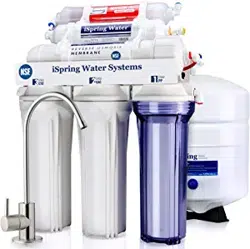Loading ...
Loading ...
Loading ...

www.123filter.com | (678) 261-7611 | Support@123Filter.com Page 22
5) Low water flow (trickle) at RO faucet
a) Tank has not been given the chance to fill. Allow approximately two hours for the tank to
fill.
b) Incoming water pressure is below 45 PSI. If this is the case, the system will need a booster
pump or permeate pump to raise the input water pressure going to the membrane. In this
scenario the tank would only fill a little or not at all.
6) High TDS in RO water
a) The system will provide a 90%+ TDS rejection rate when working properly. Meaning if
your tap water TDS is 500 ppm, the water from the system should be 50 ppm or lower.
b) Incorrect installation. Verify all connections on the system.
c) If the TDS of the tap water and water from the system are about the same, make sure the RO
membrane is in fact installed. The semi permeable membrane is blue, comes in sealed
packaging, and goes in the stage 4 membrane housing.
d) If you are getting some reduction in TDS but not 90%+, some water could be bypassing the
membrane. This could be due to a faulty automatic shut-off valve, or the membrane itself.
Contact iSpring customer support to identify the exact cause.
7) Cloudy water after installation
a) In the weeks after installing the system or changing the filters, you will see many tiny air
bubbles in the RO water. This can cause the water to appear “cloudy”. The bubbles will
disappear as the system clears itself of trapped air, and are harmless for the time being.
8) The system drains water 24/7 (continuous drain)
a) Keep in mind that it will take anywhere from 1-3 hours for the system to fill the tank from
empty, and the drain line will be trickling during this time. If the drain line continues to run
for 4+ hours, one of the following reasons could be the problem.
b) Incoming water pressure is below the minimum required level of 45 PSI. In this scenario,
the incoming water pressure is not strong enough to fill the storage tank and trigger the
system to shut off, and the system will therefore drain continuously. Adding a booster pump
or permeate pump to the system will raise the input pressure to a suitable level for the
reverse osmosis process.
c) The Automatic Shut-Off Valve (ASOV) or check valve is defective. To test if one of these
valves is the cause of the continuous drain, try the following.
i) Fill several glasses of water from the RO unit to ensure the drain water is flowing.
ii) Close the blue valve on top of the tank.
iii) Wait approximately five minutes, then remove the drain tube to check if it is still
flowing or not. If it is not flowing, the ASOV and check valve are in good working
condition.
iv) If it is still flowing, this means either the ASOV or check valve are faulty. Open
everything on the system back up and allow the tank to fill if it is not already. Tilt
the tank to check the weight and ensure that it is filled at least partially. Then close
the feed water adapter, cutting off the water supply to the system. With the tank
valve open, leave the system for 15-30 minutes, and check the weight of the tank
when you return. If it has emptied, the check valve is the source of the continuous
drain.
9) Leak from tank valve connection
a) Make sure you have applied Teflon tape to the tank threads before screwing on the tank
valve. There should be at least 8-10 wraps of Teflon tape to ensure a proper seal. If you have
done this and it continues to leak, contact iSpring customer support for an immediate
replacement.
Loading ...
Loading ...
Loading ...
